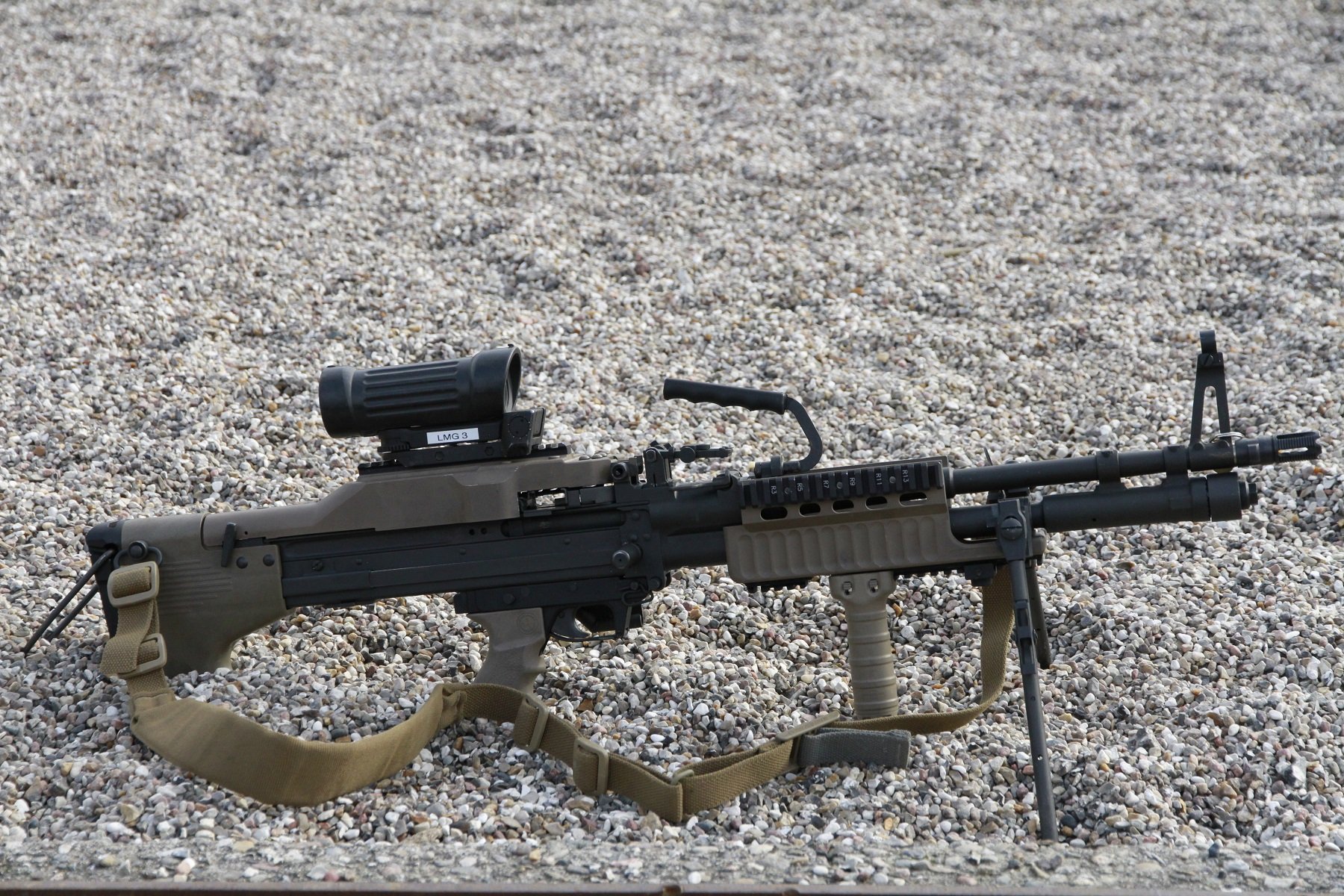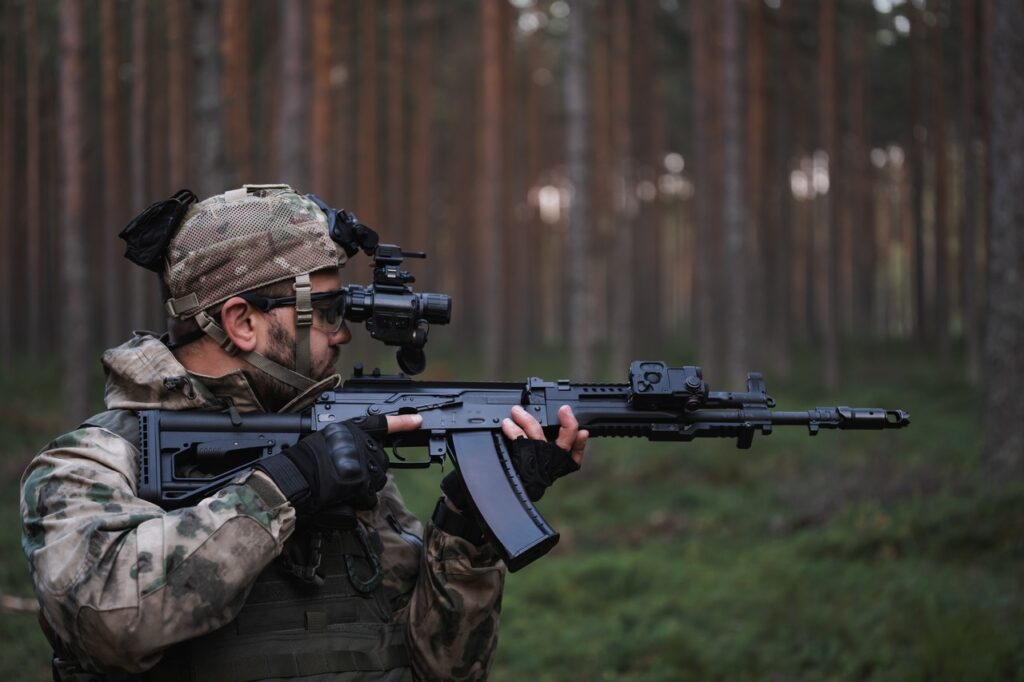
The M60E6: Same Old M60, New Improvements
Here’s What You Need to Remember: The M60 has been around since the Vietnam War. The basic platform is a good one, but it is upgraded periodically to adjust for modern improvements – and the M60E6 keeps this tradition.
The M60 is one of the enduring symbols of the American firearms industry. Born out of a fusion of two WWII-era German designs, the original M60 had several engineering flaws that lead to its replacement by the M240. But in 2014, Denmark adopted the M60E6 as the standard light machine gun of its armed forces, and the design continues to be manufactured and sold today. How did the M60 go from its rushed original design to the gun it is today?
The story of the M60 begins right after the end of WWII. During WWII, U.S. soldiers faced down the advanced MG42 machine gun and FG42 automatic rifle. While some may say the MG42’s rate of fire was too high, the weapon was far more suitable for infantry use than the American M1919A6, with superior ergonomics and lower weight. They also faced the FG42, an advanced box-fed automatic rifle that was lighter and more flexible than the American M1918A2 BAR.
Both of these weapons impressed American evaluators, who ordered Saginaw Steering Gear Division of General Motors to produce a version of the MG42 in the American .30-06 caliber. This did not go so well, with many engineering errors such as making the receiver too short. The final gun was highly unreliable, and the project was canned.
The U.S. Ordnance Corps then investigated the possibility of converting the FG42 into a belt-fed machine gun. A variety of prototypes were made. The T44 was a relatively standard FG42 converted to use the MG42’s belt feed, but the basic FG42 barrel proved too light for sustained automatic fire. The T52 came later, incorporating a heavier barrel. Later iterations of the T52 added a quick-change barrel and a new gas system.
The Army also began development of the T161 around this time, which was a variation on the T52 design, but modified for mass production. The T161 and T52 competed with each other throughout 1953 and 1954. In 1954, both guns were adapted for the new 7.62x51mm NATO round and M13 belt link, though they were not called that at the time. The T161 eventually won and went through several iterations before its final field trials as the T161E3 in 1955 and 1956.
The results of the T161E3 trials were impressive. Soldiers preferred the gun over the M1919-series of guns as it was far easier to maneuver, aim, move, and maintain. The gun weighed almost ten pounds less than the M1919A6, tipping the scales at around twenty-three pounds. The T161E3 was adopted as the M60 on 30 January 1957.
The M60 would see its first combat use in the Vietnam War in 1965 with the U.S. Marines. While it served well for many soldiers, providing heavy, accurate firepower, it also revealed many more flaws in the design.
In the door gunner role, M60s could fire upwards of 5000 rounds a day, laying down constant suppressing fire onto landing zones before helicopters came in. This caused the lightweight receivers to stretch and even crack, and gages were issued to armorers to determine when replacement should occur, which usually happened around 100,000 rounds or so. In contrast, the heavier M240 has been known to go for upwards of two million rounds without receiver repair.
The M60 feed tray could also not be closed with the bolt forwards, as this would bend parts within the belt feeding mechanism. The trigger group was also held by two pins held in with a flat spring. The plate could walk off, resulting in the trigger group falling off, sometimes resulting in a runaway gun. The gas system also tended to unthread itself. The problems with the trigger group and gas system were often rectified by wire tying the pieces into place but reflect poorly on the general state of the design.
Another big problem was with the quick change barrel. Since the bipod was on the barrel on the original M60, replacing the barrel meant the gun had to be dismounted from a firing position, maneuvered into a position to accept a fresh barrel, and remounted. This was far harder than the original MG42 barrel change.
The first attempt at fixing these problems was the M60E1, which added a cam to the feed tray cover to allow for it to be closed on a forward bolt. It also moved the bipod to the gas cylinder. However, this variant was not adopted.
Saco Defense, a large contractor for the U.S. military began resolving some of these issues in the 1980s with the M60E3 upgrade. It moved the bipod to the front handguard to resolved the barrel change issue and incorporated the cam from the M60E1. It also improved the gas system to increase reliability.
Unfortunately for Saco, the M240 had already been chosen to replace the problematic original M60s by this time, despite being heavier. However, special units like U.S. Navy Special Warfare (NSW) were still interested in the M60 due to its lighter weight. They adopted a further shortened version of the M60E3 as the M60E4 in the 1990s as the Mk43 Mod 0.
By the early 2000s, NSW began moving from the Mk43 Mod 0 to the Mk48, a version of FN Minimi chambered in 7.62 NATO, signaling the end of the M60.
However, U.S. Ordnance, a corporation founded in 1997 in Nevada, no relation to the U.S. Ordnance Corps mentioned earlier began work on a further upgrade to the M60 called the M60E6. U.S. Ordnance had been a contractor on the Mk43 Mod 0 project and thus was familiar with the M60 and what improvements it still needed.
Steve Heltzer, U.S. Ordnance’s Sales and Marketing vice president, lays out almost all of the upgrades of the M60E6 in a comment on Soldier Systems Daily.
Like the M60E1, E3, and E4 before it, the top cover can be closed with the bolt in the forward position. But on the M60E6 the feed mechanism is improved for additional “pull strength” to allow for better feeding when there is resistance on the belt.
Earlier problems with the retention of parts and parts walking out were all fixed via redesigns. Interestingly, the bipod is further updated from the M60E3 design to be stronger, simpler, and provide for better traverse when mounted.
The old problem of the M60 where different rear sight zeros were required for different barrels is resolved by adding an adjustable front sight on the barrel. The flash hider is also redesigned for better efficiency. Finally, the M60E6 adds rails to allow for the mounting of optics and lasers.
The result is a gun that’s highly competitive with the latest machine guns on the market. In independent torture testing by Dan Shea of Small Arms Defense Review, the M60E6 averaged around 8,300 mean rounds between failures, a figure better than the M60E4 or M240 during 1994 Army tests.
All of these probably resulted in the selection of the M60E6 by the Royal Danish Army in 2014. What made it competitive over competing LMGs? Probably the weight. The M60E6 is one of the lightest belt-fed light machine guns in its caliber, weighing only 9.35 kg. H&K’s competing MG5, said to be the runner-up in the trials, weighs 11.60 kg.
Does this mean that the M60E6 is the best light machine gun on the market currently? Hard to say. The FN Minimi 7.62 Mk3 is lighter at 8.8 kg, but the M60E6 holds the advantage of being cheaper for existing M60 users, as it can be purchased as a conversion kit. Either way, the M60 has come a long way from its Vietnam-era iteration.
Charlie Gao studied Political and Computer Science at Grinnell College and is a frequent commentator on defense and national security issues. This article first appeared in 2019.
Image: Wikimedia Commons


